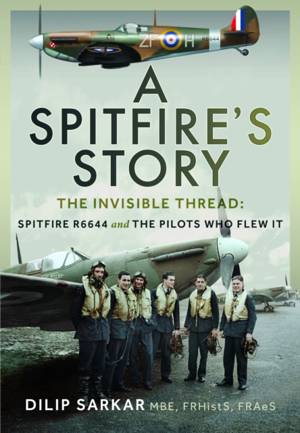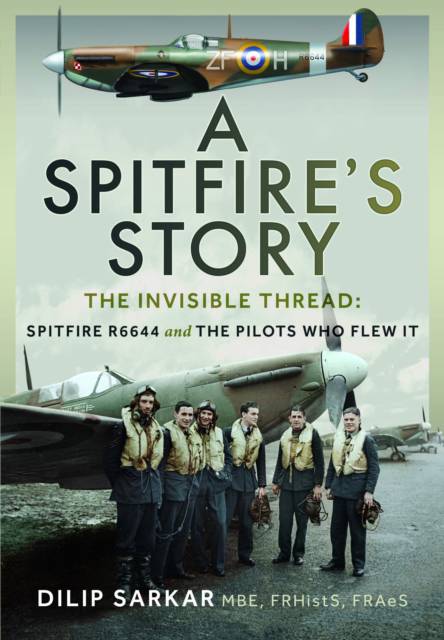
- Retrait en 2 heures
- Assortiment impressionnant
- Paiement sécurisé
- Toujours un magasin près de chez vous
- Retrait gratuit dans votre magasin Club
- 7.000.0000 titres dans notre catalogue
- Payer en toute sécurité
- Toujours un magasin près de chez vous
A Spitfire's Story
The Invisible Thread: Spitfire R6644 and the Pilots Who Flew It
Dilip Sarkar Mbe Frhists Fraes
Livre relié | Anglais
41,95 €
+ 83 points
Description
Public affection for the iconic Spitfire endures; indeed, if anything, it increases as more of these incredible aircraft are restored to airworthy condition. The Spitfire story, however, is one of people, designers, engineers, pilots, groundcrew, and more, whose lives were touched in some way by this extraordinary machine - and such stories are the inspiration for this book.
Spitfire Mk.IA R6644 was built by Supermarine at Woolston, and test-flown by the famous test pilot Jeffrey Quill on 30 May 1940. Thereafter, the aircraft was taken on charge by 5 Operational Training Unit at Aston Down. While there, it was flown by a number of The Few, new replacement pilots converting to type.
It is likely, for example, that R6644 was flown by Pilot Officer Richard Hillary, who, shot down and badly burned, became a member of the Guinea Pig Club. In his classic memoir The Last Enemy, Hillary described how 5 OTU's young pilots would fly beneath the arches of the great railway bridge spanning the Severn estuary. This inspired the famous scene in the 1980s TV series Piece of Cake, when Ray Hanna flew Spitfire MH434 beneath a bridge for the cameras. Amongst the other pilots known to have flown R6644 at Aston Down are at least two aces.
On 26 February 1941, R6644 was handed on to 65 Squadron. One of the latter's pilots who flew in R6644 was the great ace Flying Officer Brendan 'Paddy' Finucane DFC. In April, R6644 was taken on charge by the recently formed 308 (Polish) Squadron. On 11 May 1941, Pilot Officer Franciszek Surma was flying R6644 to investigate an unidentified radar plot, which transpired to be a friendly Blenheim, but was forced to abandon the Spitfire near Malvern, Worcestershire, owing to an engine fire. Surma, again one of The Few, descended safely by parachute; he was reported missing off Dunkirk during Circus 110 on 8 November 1941.
This book not only explores the men who flew R6674 throughout its wartime service, but also brings the story up to date by detailing the excavation of the Spitfire's crash site in 1987.
Spitfire Mk.IA R6644 was built by Supermarine at Woolston, and test-flown by the famous test pilot Jeffrey Quill on 30 May 1940. Thereafter, the aircraft was taken on charge by 5 Operational Training Unit at Aston Down. While there, it was flown by a number of The Few, new replacement pilots converting to type.
It is likely, for example, that R6644 was flown by Pilot Officer Richard Hillary, who, shot down and badly burned, became a member of the Guinea Pig Club. In his classic memoir The Last Enemy, Hillary described how 5 OTU's young pilots would fly beneath the arches of the great railway bridge spanning the Severn estuary. This inspired the famous scene in the 1980s TV series Piece of Cake, when Ray Hanna flew Spitfire MH434 beneath a bridge for the cameras. Amongst the other pilots known to have flown R6644 at Aston Down are at least two aces.
On 26 February 1941, R6644 was handed on to 65 Squadron. One of the latter's pilots who flew in R6644 was the great ace Flying Officer Brendan 'Paddy' Finucane DFC. In April, R6644 was taken on charge by the recently formed 308 (Polish) Squadron. On 11 May 1941, Pilot Officer Franciszek Surma was flying R6644 to investigate an unidentified radar plot, which transpired to be a friendly Blenheim, but was forced to abandon the Spitfire near Malvern, Worcestershire, owing to an engine fire. Surma, again one of The Few, descended safely by parachute; he was reported missing off Dunkirk during Circus 110 on 8 November 1941.
This book not only explores the men who flew R6674 throughout its wartime service, but also brings the story up to date by detailing the excavation of the Spitfire's crash site in 1987.
Spécifications
Parties prenantes
- Auteur(s) :
- Editeur:
Contenu
- Nombre de pages :
- 328
- Langue:
- Anglais
Caractéristiques
- EAN:
- 9781036138523
- Date de parution :
- 31-12-25
- Format:
- Livre relié
- Format numérique:
- Genaaid
- Dimensions :
- 171 mm x 248 mm
- Poids :
- 1022 g

Seulement chez Librairie Club
+ 83 points sur votre carte client de Librairie Club
Les avis
Nous publions uniquement les avis qui respectent les conditions requises. Consultez nos conditions pour les avis.






